Terril gets to shooting the Henry Casehardened Big Boy 357 Magnum Rifle.
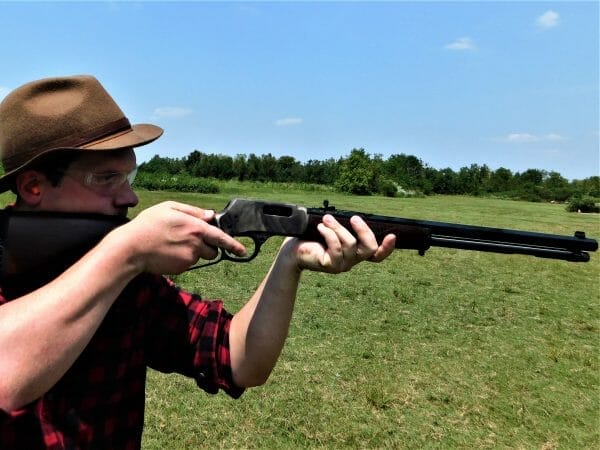
I grew up in a deer-hunting environment in the American South. The animals are cunning, and the distances close.
The lever action rifle is reasonably fast to shoot, accurate, and handy for hunting in thick brush. As such it was a popular choice where I came from, and chances are they are still kicking around where you are too.
Go into any gun store, and you will find a lever gun solution to any problem. When I first started my unfortunate habit of casing gun stores, I had a habit of going to the lever guns first. Marlins and Winchesters were by far the most common, but Henry Arms was making some serious inroads. Their Big Boy pistol caliber rifles in 357 Magnum and 44 Magnum were especially predominant at my favorite hunting spot.
Eventually, my interest turned elsewhere, but as too often, I found myself circling back and wanting one. A recent peek in the Henry Arms catalog showed many different models to choose one. Frankly, there were too many choices, but I ended up with the Henry Casehardened chambered in the very familiar 357 Magnum cartridge.
Overall Features and First Impressions
The Henry Casehardened Big Boy .357 Magnum Rifle is a lever-action firearm featuring a distinctive case-hardened finish on its steel frame, chambered for both .357 Magnum and .38 Special ammunition.
The Henry Casehardened Big Boy 357 Magnum Rifle shares most of the same features as most of the “Big Boy” rifle series. The rifle wears a heavy twenty-inch octagonal barrel with standard sights—a beaded post front and an adjustable buckhorn rear. Underneath the barrel is the magazine tube. Like all Henry rifles, there is no loading gate on the side of the receiver, but the rounds are dropped in at the front of the tube.
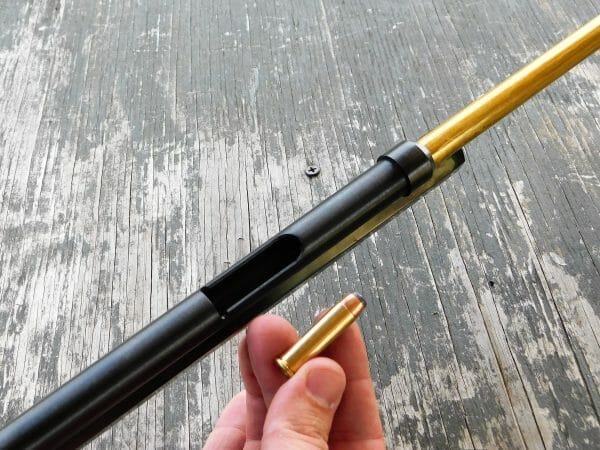
Smartly, there are sling swivels—one anchored in the buttstock and the other integral to a casehardened steel nose cap forward of the fore-end. Though this ten-shot rifle is geared toward close shooting, the receiver is tapped and drilled for a scope mount which may be desirable for some shooters.
The very first thing I noticed about the Casehardened Henry Rifle was the beautiful color casehardened finish on the receiver and its corresponding nose cap. This random, dappled pattern of browns, blacks, and reds was the primary reason or selecting this model. I can appreciate a good case hardening job, having done plenty of metal parts myself. In an era of blued and stainless steel, it is refreshing and, in some ways, a lost art. Steel is heated to high temperatures before it is introduced to a source of carbon, and said carbon is cooked onto the metal. What you end up with is not only a beautiful finish but also a steel that is very hard on the surface while still being soft internally to resist stress. Casehardening is also a surprisingly good way of warding off the rust.
But my admiration also turned to a bit of frustration. The casehardening was left in the raw. There is a certain simplistic charm to this, but I figured after so much effort that Henry would give it a polish.
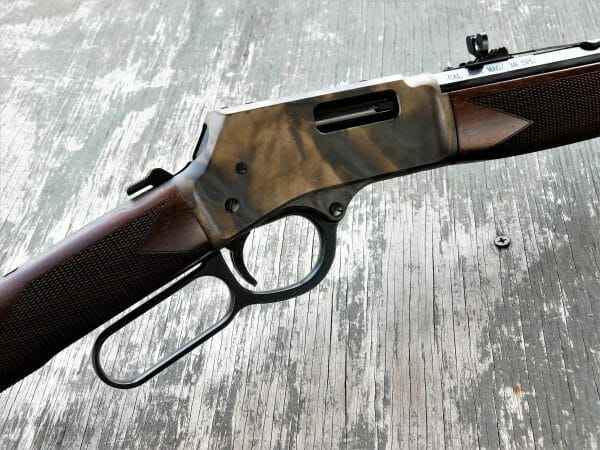
Despite this little qualm, fit and finish were excellent, with no inlaying gaps, and the checkering was well-placed and well-executed. As one would expect from a Henry, the action worked smoothly with a flick of the wrist. No grit, no slop. Nitpicking aside, I was excited. The pistol caliber lever action has always been espoused as handy and easy to shoot. I am no stranger to the 357 Magnum and 38 Special cartridges that this Henry eats, so I had plenty of ammo on hand to test. I was sure it would be a fun time. These blued steel components are matted smartly to a color casehardened steel frame and a corresponding American walnut buttstock and fore-end. The buttstock has a traditional straight comb and grip that rides along the gun’s lever action, terminating to a hefty rubber buttpad.
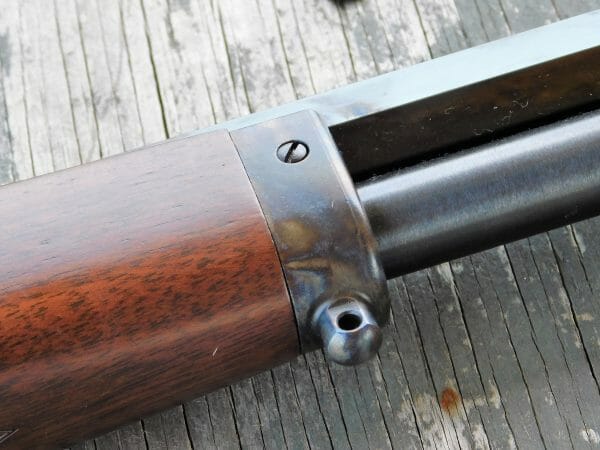
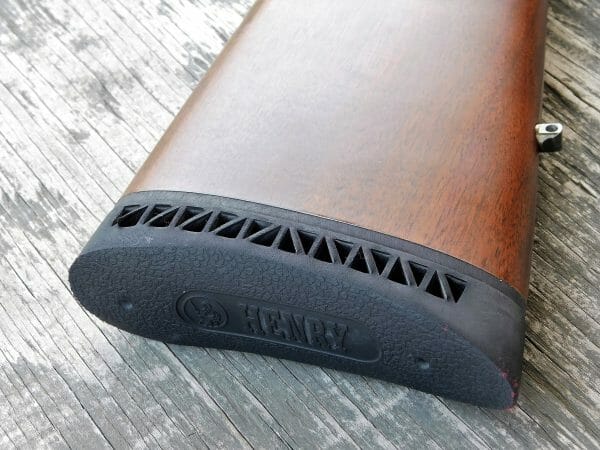
I took the Henry Casehardened for several range trips with my usual amount of ammunition—300 rounds of both 357 Magnum and 38 Special ammunition. A pistol caliber lever gun seemed like a recipe for fun without a bruise on the shoulder, so I threw testing into the wind for a moment and proceeded to shoot at a steel plate at fifty yards.
Loading the Henry Casehardened Big Boy is just like any other Henry. Twisting the knurled locking bolt at the end of the magazine tube frees the brass spring housing, and moving the housing upward will expose the loading port. Drop your rounds in one at a time until the magazine is full before pushing the housing back down and twisting the locking bolt back into its mortise.
After loading ten magnum rounds, I stepped out into the open, flicked my wrist to chamber a round, and let fly, albeit in a safe manner. Offhand, I was able to hit that eight-inch plate with every shot. Unfortunately, those ten rounds didn’t last long, and I retreated to the bench to start some official accuracy testing.
Live Inventory Price Checker

DoubleTap DT Hunter 180 Grains .357 Magnum Ammunition 20 Rounds Hardcast Lead FN
GrabAGun
$
22.89
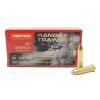
Norma Range and Training 158 gr FMJ .357 Magnum Ammunition 50 Rounds - 620640050
Palmetto State Armory
$
28.99

DoubleTap DT Hunter 200 Grains .357 Magnum Ammunition 20 Rounds
GrabAGun
$
22.89

Winchester Silver Tip 145 gr JHP .357 Magnum Ammunition 20 Rounds - W357ST
Palmetto State Armory
$
25.99
My loadout for the Henry consisted mostly of 158-grain projectiles, a thoroughly average weight for 357 Magnum, and its lighter-powered 38 Special parents. 38 Special loadings included LAX full metal jacket reloads, the old school Federal American Eagle round-nosed lead load, and the pedestrian but proven Winchester White Box 125 grain +P jacketed hollow point. The 357 Magnums tested include Hornady’s American Gunner, LAX Magnum reloads, and PPU 158 grain hollow points.
Knowing I could get on paper at fifty yards, I loaded up some LAX magnum rounds and benched the rifle. The first group was six inches lower than my aiming point, and I had to adjust the ladder on the rear sight up two steps to hit dead-on at that distance. With all ammunition, all rested groups came in at two inches or less with the cheap PPU fodder taking the cake with a firm one-inch bullseye group.
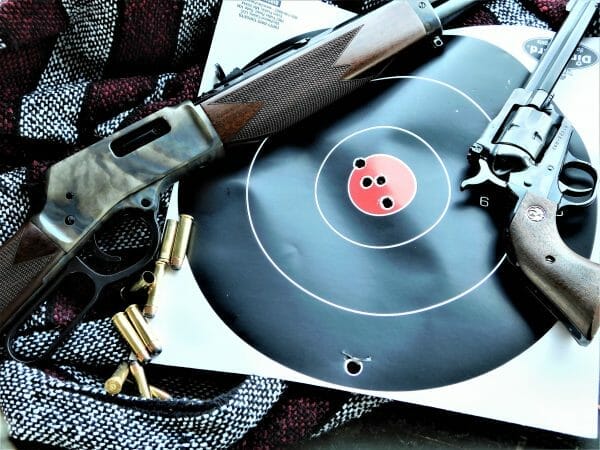
Next came the one-hundred-yard test, which proved to be far more exciting and challenging. As I lined up my sights on the twelve-inch bullseye, I was quick to realize that the front post was covering up most of that target. I was expecting this.
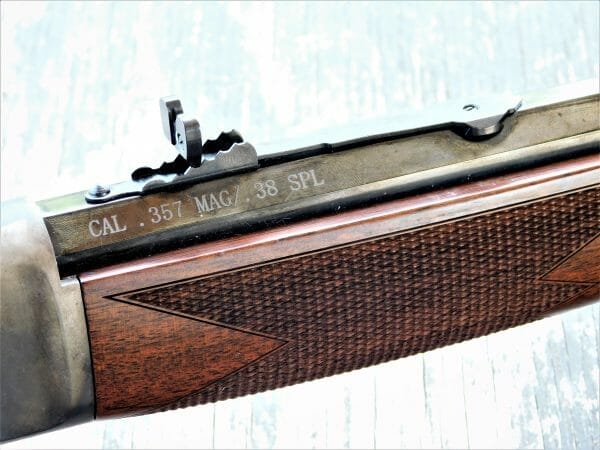
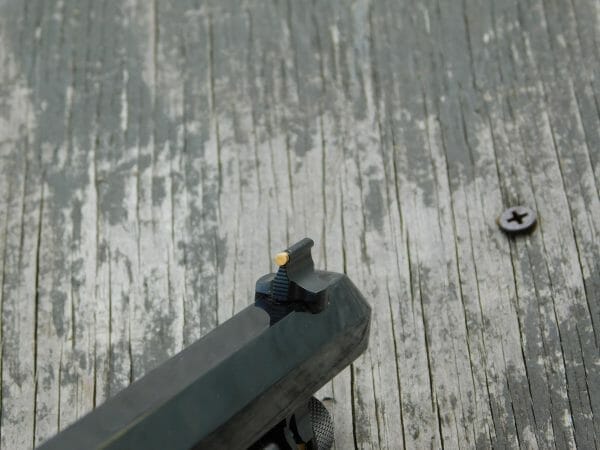
Most Henry rifles come equipped with that semi-buckhorn rear sight and that post front, and I have always found, whether I am shooting a Henry Golden Boy in 22 LR or their massive hitting 45-70, I found myself maxed out at about seventy-five yards. That front sight is likely thicker than it needs to be, and it tends to cover up small targets, though this may present far less of a problem if you are hunting large game instead of an artificially created target. I held just under the bullseye to keep a consistent aiming point and took care to shoot my five-shot groups. The results were a clear case of why a scope isn’t such a bad idea. It didn’t help that my eyesight is starting to fail, and my front sight blurred with the target from time to time. Still, I expected far worse than the six-inch groups I was getting using the PPU Magnums still flying true into the center of the target while the slower-moving 38 Special rounds were dropping six inches low at that distance. I concluded that the Henry Big Boy with these stock sights would be more than adequate in brush country, but a scope would help for longer shots.
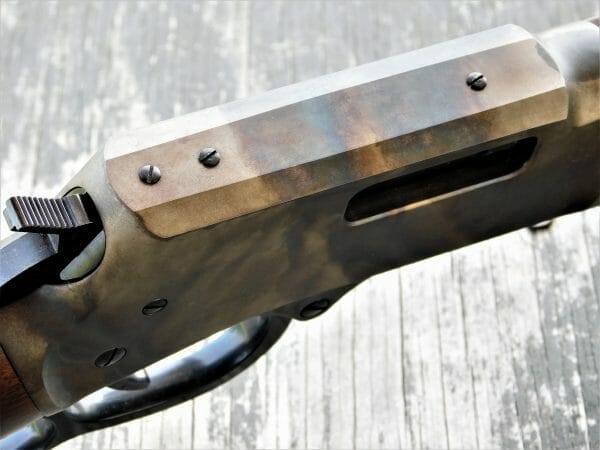
Handling, Reliability, and Power
The Henry Casehardened Big Boy proved to be more accurate than I originally anticipated, given the sights and the lack of high-grade ammunition. Regarding handling, the Casehardened is far from the lightest rifle at just under eight pounds. This is thanks in no small part to the heavy octagonal barrel, which is attractive and gives the rifle an excellent muzzle-heavy feel for steady off-hand shooting.
Though I would much rather deal with a loading gate, I didn’t have any issues loading the magazine tube, nor did I have any cycling issues. The action was quite smooth, and the lever seemed to break open after the rifle recoiled in my hands, allowing me to cycle the rifle that much faster. The trigger has no take-up, but my finger was greeted with a six-pound wall before a clean, surprising break. This defiantly helped with accuracy.
Regarding reliability, lever actions can be finicky about flat-point bullet feeding. Those LAX flat-nosed reloads worked like a charm and felt recoil from all these loads was minuscule. There was hardly any muzzle rise whether you were shooting 38 Special or 357 Magnum rounds, but the 38 Special rounds were much quieter, and at some points, I questioned whether the gun had fired. This equates to a rifle that is fast to fire and entirely unintimidating for shooters, both new and old, strong or delicate.
But this UN-intimidating quality is no good if you can’t do anything with the rifle. Shooting a 22 LR at small game is one thing, but when you upgrade to centerfire calibers, you should expect centerfire capabilities. For self-defense, both the 357 Magnum and 38 Special cartridges are storied and respected chamberings, but putting these rounds into a rifle changes the game a bit.
You will get much more power out of a twenty-inch barrel versus a two to four-inch barreled revolver, and it was born out after a brief session over my Caldwell chronograph when I paired the Henry with a four-inch Smith & Wesson Model 27 revolver. Out of the revolver, I fired my Hornady American Gunner 357 Magnum hollow points over the chronograph. A five-shot string resulted in an average velocity of 1,318 feet per second—a bit anemic by Magnum standards. The same ammunition shot from the Henry gave us an average speed of 1,958 feet per second. That is significant by any standard.
Henry Casehardened Big Boy 357 Magnum Rifle Specs:
- Product: Henry Casehardened Big Boy 357 Magnum Rifle
- Brand: Henry Arms
- Model Number: H012GMCC
- UPC: 619835200389
- Action Type: Lever Action
- Caliber: .357 Magnum/.38 Spl
- Capacity: 10 Rounds
- Barrel Length: 20″
- Barrel Type: Octagon Blued Steel
- Rate of Twist: 1:16
- Overall Length: 37.5″
- Weight: 7.84 lbs.
- Receiver Finish: Color Case Hardened Steel
- Rear Sight: Fully Adj. Semi-Buckhorn w/ Diamond Insert
- Front Sight: Brass Bead
- Scopeability: Drilled and Tapped
- Scope Mount Type: BB-RSM
- Stock Material: American Walnut
- Buttplate/Pad: Black Solid Rubber Recoil Pad
- Length of Pull: 14″
- Safety: Transfer Bar
- Best Uses: Target/Hunting
- Embellishments/Extras: Swivel Studs, Side Gate
- User Manual: PDF
- M.S.R. Price: $1,246.00
Live Inventory Price Checker
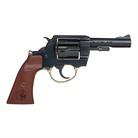
|
Henry Repeating Arms Big Boy 357 Magnum/38 Special Revolver | Brownells.com | $ 772.99 |
|
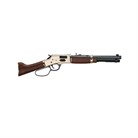
|
Henry Repeating Arms Big Boy Mare's Leg 357 Magnum/38 Special Lever Action Handgun | Brownells.com | $ 1029.99 |
|
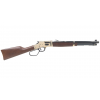
|
Henry Big Boy Brass .357 Magnum / .38 Special Lever Action Rifle - 16.5" | Rainier Arms | $ 999.99 |
|

|
Henry Big Boy Carbine 357 Magnum/38 Special 7 Round Large Loop Lever-Action Rifle - H006MR | Palmetto State Armory | $ 999.99 |
|
Henry Casehardened Big Boy 357 Magnum Rifle: Final Thoughts
The Henry Casehardened Big Boy 357 Magnum Rifle is an attractive addition to Henry’s dizzying lineup. Though the lack of polish and a loading gate will confound traditionalists—and me—the Casehardened did what I expected any Henry to do—to put rounds on target and look good doing it. Regarding function, I usually find fault somewhere with Henry rifles in certain situations with specific loads, but not this time. All ammunition fed and fired flawlessly, and the controls are smooth to work. Despite the sight limitations, I found myself shooting this 357 Magnum better than some of Henry’s 22 rimfires, and indeed the accuracy is ample for taking up to deer-sized game within one hundred yards. The additional power squeezed out of a rifle barrel is coupled with the general lack of “kickback,” something a new shooter moving up from .22 rimfires can appreciate. In the end, I came away placing more faith in pistol caliber lever guns than I did before. These were always very popular but, at least for a time, not looked upon by some hunters as serious game getter compared to rifle rounds like the 30-30 or 45-70. Admittedly, I went along with that stigma and stuck with 30-30s but coming away from this new experience, I found the 357 Magnum to be up to the task without the need for specialized ammo or coming away with a sore shoulder or other bad habits.
Whether you are a fan of the magnum rounds, a new shooter, or an experienced brush hunter, the Henry Big Boy Rifle models are a great choice, and the Henry Casehardened Big Boy 357 Magnum Rifle is perhaps the nicest of the bunch.
Related: Henry AR-7 Survival Rifle
About Terril Hebert:
Terril Hebert is a firearm writer native to south Louisiana. Under his motto-Guns, Never Politics-he tackles firearm and reloading topics both in print and on his Mark3smle YouTube channel, where he got his start. Terril has a soft spot for ballistics testing, pocket pistols, and French rifles. When he is not burning ammo, he is indulging his unhealthy wildlife photography obsession or working on his latest novel. Scourge of God, published in 2017. See more from Terril on youtube under Mark3smle

I just bought me the Henry 357 mag.hard steel 20 inch barrel,I put me a Nikon buckmaster 2 3/9/40 scope on it.and yesterday was opening rifle season here in Virginia,so I took it hunting with me on my farm for the first time.and killed me a 7 point buck at 155 yards away,and it dropped like a rock using magtech 158 grain sp bullets.my scope is a bdc scope,so with each circle my a rifle shoots 100 yards and on in on the main cross hair.and 50 yards for each circle on my scope,so it goes 100,150,and on and on.i… Read more »
Have had one for the past couple of months. Definitely one of the best looking rifles I own. I agree with author about the case hardening. The rough finish makes the rifle look unfinished, but I guess polishing would increase the cost too much. I don’t agree about the cycling. My rifle absolutely will not cycle 38s and will not cycle many 357s. The action seems very loose and sloppy. The lever while hanging down is very sloppy as if it is missing shims. It is a beautiful rifle but is of less worth if not reliable. Maybe I just… Read more »
Nice looking rifle, but for myself, I wish it wasn’t tube loaded.
O’ I for got to day I ordered me the big loop and put it on my 357 mag.steel big boy, because I have to shoot left handed now because I lost my right eye years ago.and I’m not left handed eather,plus I have arthritis in my fingers and hand very bad.and with the big loop it helps me cock and chamber a bullet alot easier.
158 grain 357, 158 grain 38 special cured my feeding problem on my Henry, less weight on 38 causes the round to flop around and not chamber. Still a lot of fun to shoot!
$800 for pistol caliber carbine.(.357)
$400 for rifle caliber carbine.(30-30)
You can buy a lot of ammo with the extra $400.